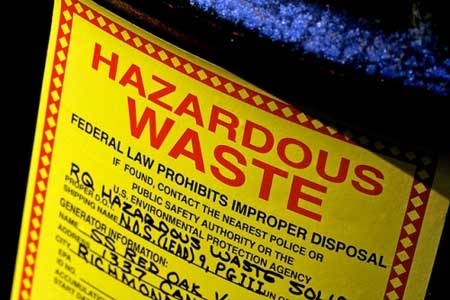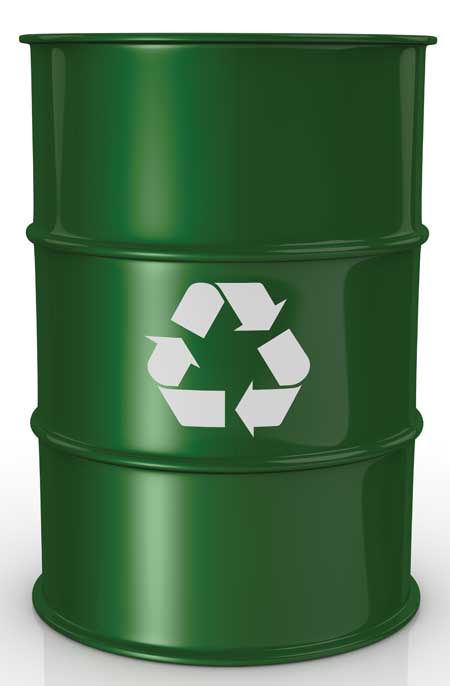The amount of used oil and other hazardous solvents can pile up in a hurry when you’re hustling through the day’s engine work. Then you realize the space at the back of your shop is getting cluttered and your waste tank is filling up. It’s time to take care of the waste. From the early days of automotive repair, shop owners and technicians have found creative ways to rid their garage of shop’s leftovers.
“Fifty years ago, garage guys would soak the oil in some gas, scrub it and use it on the grass to kill the weeds,” said Buddy Judy, marketing manager of Safety Kleen’s Motorsports program. “Or they soaked a couple of logs in it to heat up the shop. Whatever they did with it, a lot of times it wasn’t the healthiest thing for them or the environment.”
And Judy would be correct. The hazardous waste that quietly lies in your garage contains harmful solvents including one of the most detrimental chemicals, Percholorethylene. Better known as a basic dry cleaning chemical, its exposure is one of the leading causes of cancer and lung disease.
In addition, a little bit of oil waste goes a long, destructive way. From one simple oil change, the wasted amount that’s dumped in a drain is enough to contaminate one million gallons of fresh water.
Knowing the dangers caused by such waste, the U.S. Congress passed the Resource Conservation and Recovery Act (RCRA) in 1976. The act currently sets the standards for management of all waste and used oils.
In addition to using it as a helpful gardening solution, used oil has been a source for many a shop’s waste heater. Dean Yatchyshyn, owner of high-performance engine shop Cresap Automotive Machine in Cumberland, MD, finds the method rewarding.
“We save the waste oil that comes out of our motors and we got a waste oil heater,” he said. “We use that in the winter time to supplement our heating system to keep costs down on that. Plus, you know, it’s got to go somewhere.”
If done right to the code of OHSA and EPA rules, having an energy efficient heater can rid your shop of its waste while serving a good use. Most states require a permit to operate a waste oil heater and such regulations vary. Judy contends, for some, it might not be worth the hassle, plus there are other ways to handle a shop’s excess.
“I know, for instance, in Mecklenburg County, NC, it is pretty hard to get a permit for guys to operate a waste heater. You are only allowed to burn your used oil,” he said. “Think about how many gallons you’ll burn in a day: Are you going to produce that many gallons over the course of the year? You may not have the volume. And to take in others’ oil, you have to apply to get a special oil burner permit and that can be pretty hard to come by.”
“(Waste heaters) can be a lot of hassle. And quite honestly, for the same money, most shops can throw some solar panels on the roof to get a lot faster heating and sell their used oil off,” he noted.
Solar-powered radiant heating can be an alternative source in some climes. The apparatus uses the sun as the heating source. The electromagnetic wave energy travels at the speed of light until it hits an object that converts it to heat throughout the space. Other sources can also be used to power a radiant heating system.
“One thing we did in our facility seven years ago was to put in a radiant system,” said Mike Eighmy of Precision Automotive Diesel in Rockford, IL. “It heats the concrete slab and is very efficient in our shop.”
Eighmy also follows Judy’s advice when it comes to handling his shop’s waste. He enlisted a service from his local treatment facility that properly hauls and treats the wastewater and machine waste from his shop on a regular basis.
Businesses such as Judy’s Safety Kleen and Enercon, another full-service environmental firm, provide disposal and recycling services that take the headache out of waste management. Like Eighmy, Yatchyshyn leaves the materials to a qualified entity.
“With hazardous materials, we use Enercon’s disposal service for the waste we have,” he said. “We buy our chemicals from them and they have an arrangement where they pick up the used chemicals and our waste water.”
Yatchyshyn’s shop also recycles its rinse water from the cleaning equipment. A rinse tank where chemicals are washed out moves the water back into the tank. A secondary rinse captures the rinse water, which is used for make-up water in the shop’s spray washers.
“We are keeping the chemical costs down as well as the carbon footprint by re-using the water as much as we can,” he said.
Frank Honsowetz of Ed Pink Racing in Van Nuys, CA, explains his 12,000-plus square-foot facility deals in 300-gallon large tanks of used motor oil and regular solvents frequently. In his state, efficiency regulation for oils and solvents is a way of life. “We are very careful of mixing those things,” he said. “We also have a separate tank for wastewater.”
For Honsowetz’s shop and others in the Golden State, waste disposal is as common as breathing. Used oil comprises the highest volume of hazardous waste generated in California with approximately 100 million gallons being recycled in the state each year.
The California Oil Recycling Enhancement Act of 2009 discourages the illegal disposal of used oil. Enforced by the state’s department of Resources Recycling and Recovery (CalRecycle), the law requires oil manufacturers to pay CalRecycle a fee per gallon of lubricating oil sold in the state. CalRecycle then makes incentive payments to eligible oil collection centers and programs.
“I think the whole practice is more established in California than other places,” Honsowetz said. “Price is not exorbitant and it’s easy to do. I don’t consider it a burden. It’s just a part of how we do business now.”
Ed Pink Racing works with Safety Kleen to discard its waste. The used oil is recycled and through Safety Kleen’s re-refining process, the oil returns to its original state.
“If you have a 1,000-gallon tank, you have a commodity on your hands, and that material we would refine or use as fuel in a power plant,” Judy said. “Used oil is exactly that…used oil. Nothing else is in it.
“If a shop typically burns its used oil yet it has some brake or choke spray where they have been cleaning the engine blocks, they’re not supposed to burn that,” Judy continued. “So, it is not the greenest of things and most solvents don’t burn efficiently.”
Companies like Safety Kleen and Enercon own and operate several fuel blending facilities across North America. In Safety Kleen’s case, the plants blend hazardous material such as oils and other solvents into an alternative fuel source for cement kilns that are used for the pyroprocessing stage to manufacture Portland and other types of hydraulic cement. It provides kilns with a green alternative to coal, oil and other fossil fuels.
“It’s better to have it recycled so companies can use that oil and make gasoline or commercial fuel out of it,” Judy said. “Those options are better than doing it yourself.”
But what about those shops that don’t deal in those huge volumes of oil over the course of a year like Ed Pink Racing or Cresap Automotive Machine? Judy says Safety Kleen works with more than 10,000 retailers that handle oil and waste disposal through a used oil recycling program via EPA and Earth911 initiative, Infinity Resources’ recycling division.
The efforts of efficiently handling your hazardous waste can amount to significant costs. According to the Environmental Protection Agency, on average it would cost $1,200 to ship a 55-gallon drum of hazardous material and more than $100 a month for containers, labels and time to manage shop waste. Using a professional service can save you many of these costs as well as the hassle and legal challenges of doing it yourself.
“We do a lot of recycling because we have a lot of stuff to get rid of, but it helps to have recycling companies work with us to recoup a little bit of costs,” Honsowetz said. “We are encouraged to do that for the environment and for the bottom line.”
A Good Waste Management system requires automotive shops to:
• Identify all wastes generated: Determine which ones are hazardous waste
• Determine pounds of hazardous waste per month: Keep records
• Identify options for getting rid of waste including used oil
• Identify HW management standards
• Train staff on waste management
• Minimize waste/recycle
Source: Environmental Protection Agency


 To download the Green Strategies Guide, click here.
To download the Green Strategies Guide, click here.













